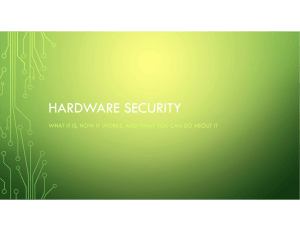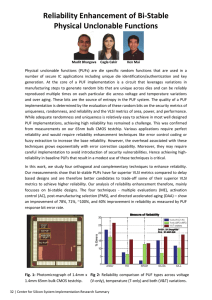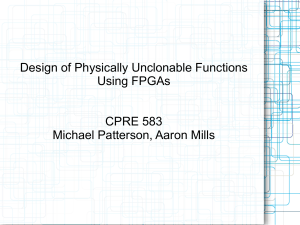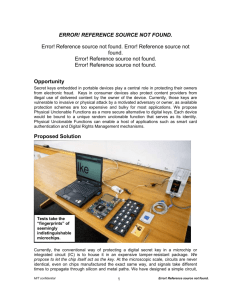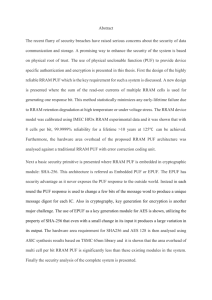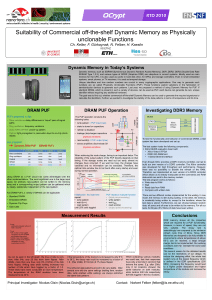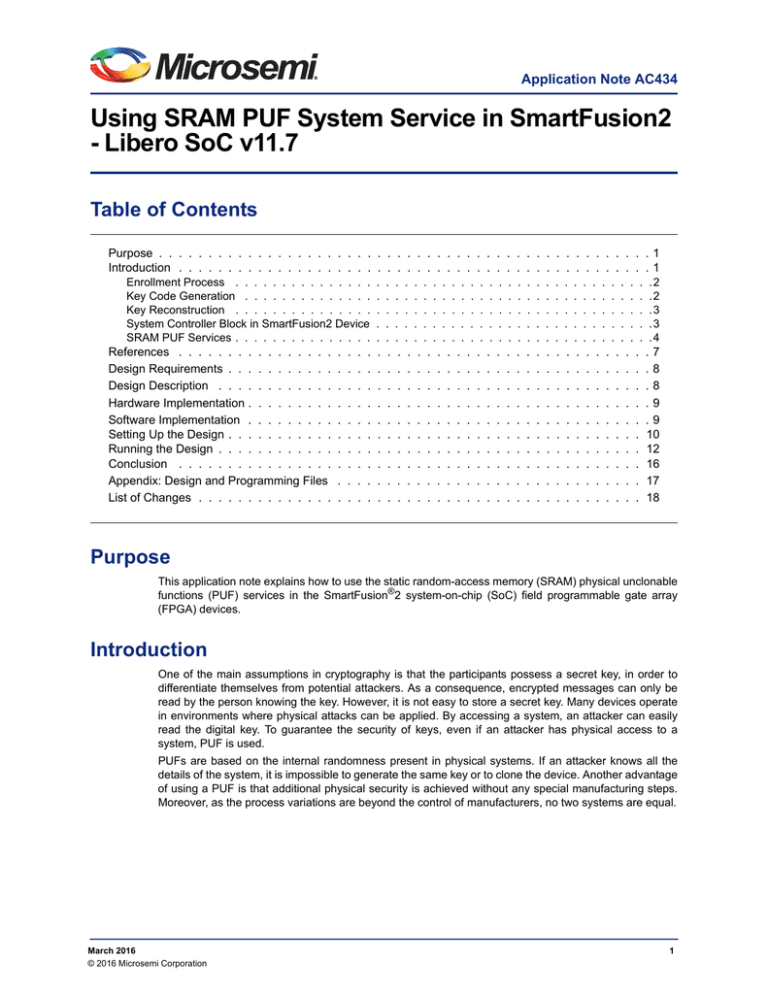
Application Note AC434
Using SRAM PUF System Service in SmartFusion2
- Libero SoC v11.7
Table of Contents
Purpose . . . . . . . . . . . . . . . . . . . . . . . . . . . . . . . . . . . . . . . . . . . . . . . . . . 1
Introduction . . . . . . . . . . . . . . . . . . . . . . . . . . . . . . . . . . . . . . . . . . . . . . . . 1
Enrollment Process . . . . . . . . . . . . . . .
Key Code Generation . . . . . . . . . . . . . .
Key Reconstruction . . . . . . . . . . . . . . .
System Controller Block in SmartFusion2 Device
SRAM PUF Services . . . . . . . . . . . . . . .
References . . . . . . . . . . . . . . . .
Design Requirements . . . . . . . . . . .
Design Description . . . . . . . . . . . .
Hardware Implementation . . . . . . . . .
Software Implementation . . . . . . . . .
Setting Up the Design . . . . . . . . . . .
Running the Design . . . . . . . . . . . .
Conclusion . . . . . . . . . . . . . . . .
Appendix: Design and Programming Files
List of Changes . . . . . . . . . . . . . .
.
.
.
.
.
.
.
.
.
.
.
.
.
.
.
.
.
.
.
.
.
.
.
.
.
.
.
.
.
.
.
.
.
.
.
.
.
.
.
.
.
.
.
.
.
.
.
.
.
.
.
.
.
.
.
.
.
.
.
.
.
.
.
.
.
.
.
.
.
.
.
.
.
.
.
.
.
.
.
.
.
.
.
.
.
.
.
.
.
.
.
.
.
.
.
.
.
.
.
.
.
.
.
.
.
.
.
.
.
.
.
.
.
.
.
.
.
.
.
.
.
.
.
.
.
.
.
.
.
.
.
.
.
.
.
.
.
.
.
.
.
.
.
.
.
.
.
.
.
.
.
.
.
.
.
.
.
.
.
.
.
.
.
.
.
.
.
.
.
.
.
.
.
.
.
.
.
.
.
.
.
.
.
.
.
.
.
.
.
.
.
.
.
.
.
.
.
.
.
.
.
.
.
.
.
.
.
.
.
.
.
.
.
.
.
.
.
.
.
.
.
.
.
.
.
.
.
.
.
.
.
.
.
.
.
.
.
.
.
.
.
.
.
.
.
.
.
.
.
.
.
.
.
.
.
.
.
.
.
.
.
.
.
.
.
.
.
.
.
.
.
.
.
.
.
.
.
.
.
.
.
.
.
.
.
.
.
.
.
.
.
.
.
.
.
.
.
.
.
.
.
.
.
.
.
.
.
.
.
.
.
.
.
.
.
.
.
.
.
.
.
.
.
.
.
.
.
.
.
.
.
.
.
.
.
.
.
.
.
.
.
.
.
.
.
.
.
.
.
.
.
.
.
.
.
.
.
.
.
.
.
.
.
.
.
.
.
.
.
.
.
.
.
.
.
.
.
.
.
.
.
.
.
.
.
.
.
.
.
.
.
.
.
.
.
.
.
.
.
.
.
.
.
.
.
.
.
.
.
.
.
.
.
.
.
.
.
.
.
.
.
.
.
.
.
.
.
.
.
.
.
.
.
.
.
.
.
.
.
.
.
.
.
.
.
.
.
.
.
.
.
.
.
.
.
.2
.2
.3
.3
.4
.7
.8
.8
.9
.9
10
12
16
17
18
Purpose
This application note explains how to use the static random-access memory (SRAM) physical unclonable
functions (PUF) services in the SmartFusion®2 system-on-chip (SoC) field programmable gate array
(FPGA) devices.
Introduction
One of the main assumptions in cryptography is that the participants possess a secret key, in order to
differentiate themselves from potential attackers. As a consequence, encrypted messages can only be
read by the person knowing the key. However, it is not easy to store a secret key. Many devices operate
in environments where physical attacks can be applied. By accessing a system, an attacker can easily
read the digital key. To guarantee the security of keys, even if an attacker has physical access to a
system, PUF is used.
PUFs are based on the internal randomness present in physical systems. If an attacker knows all the
details of the system, it is impossible to generate the same key or to clone the device. Another advantage
of using a PUF is that additional physical security is achieved without any special manufacturing steps.
Moreover, as the process variations are beyond the control of manufacturers, no two systems are equal.
March 2016
© 2016 Microsemi Corporation
1
Using SRAM PUF System Service in SmartFusion2 - Libero SoC v11.7
The initial power-up values of SRAM behave randomly and independently due to manufacturing
differences such as:
•
Thickness of gate dielectric
•
Number of atoms diffused into channel region
•
Other random process variations
SRAM PUF can be used for the generation of keys in any data security application, because of its
randomness and device individual fingerprint. The primary advantage of SRAM PUF for generating keys
is that the keys are dynamically reconstructed without storing in memory. Keys are generated only when
needed on-the-fly. In addition, SRAM PUF is easy to implement in hardware. The SRAM PUF generates
a device-individual fingerprint using the startup behavior of SRAM. It can serve as a root of trust and
provides a key that cannot be easily reverse engineered.
SRAM PUF is unique for each chip as the physical characteristics are unique for each chip, difficult to
predict, easy to evaluate, and reliable.
SRAM PUF feature is available in the larger SmartFusion2 devices, such as:
•
M2S060TS
•
M2S090TS
•
M2S150TS
In the M2S060TS, M2S090TS, and M2S150TS devices, SRAM PUF is accessible through system
services. The system services are system controller actions initiated by asynchronous events from the
ARM® Cortex®-M3 processor or a fabric master in the SmartFusion2 devices.
To use SRAM PUF for key generation, the following steps are involved:
•
Enrollment Process: Used for creating activation code.
•
Key Code Generation: Uses activation code and intrinsic or extrinsic keys to generate key
codes.
•
Key Reconstruction: Uses activation code and key codes to reconstruct the intrinsic or extrinsic
keys.
Enrollment Process
The initial step for key generation using SRAM PUF is the enrollment process. Enrollment process
creates an activation code using start up states of the SRAM PUF. The activation code size is 1192 byte,
it is stored in the embedded nonvolatile memory (eNVM). The activation code is used for key code
generation and key reconstruction. Enrollment is required only for the first time. However, the device can
be enrolled multiple times, producing a new activation code for each enrollment. In this case, previous
key codes generated using the older activation codes becomes invalid, making the key reconstruction
not possible.
For more information about Enrollment Process, see the SRAM-PUF Enrollment Service section in the
UG0443: SmartFusion2 and IGLOO2 FPGA Security and Reliability User Guide.
Key Code Generation
Key codes are generated using intrinsic or extrinsic keys. Intrinsic keys are automatically generated by
the SRAM PUF core. Extrinsic Key option allows user to supply the required keys manually for KeyCode
generation.
For each intrinsic key or extrinsic key, a key code is generated. Multiple key codes can be generated
from multiple intrinsic or extrinsic keys.
2
Introduction
Key Reconstruction
The keys have to be reconstructed because they are not stored in the memory. To reconstruct the keys,
activation code and key codes are required, as shown in Figure 1.
SRAM PUF core reconstructs the original intrinsic or extrinsic keys.
Activation Code
Key Code 2
SRAM PUF Core
Key Code 3
Key 2
Key 3
Figure 1 • Key Reconstruction
This application note also provides the design example to access the following SRAM-PUF services. For
more information on SRAM-PUF services, see "SRAM PUF Services" section on page 4.
•
Create user AC (Activation Code)
•
Delete user AC
•
Get number of KC (Key Code)
•
Create user KC for an intrinsic key
•
Create user KC for an extrinsic key
•
Export all KC
•
Import all KC
•
Delete user KC
•
Fetch a user PUF key
•
Get a PUF seed
System Controller Block in SmartFusion2 Device
The SRAM PUF services provide access to the system controller’s PUF core. SRAM PUF core block is
accessed through the communication block (COMM_BLK).
There are two COMM_BLK instances located in:
•
Microcontroller subsystem (MSS)
•
System controller
The COMM_BLK consists of an APB interface, eight byte transmit FIFO, and eight byte receive FIFO.
The COMM_BLK provides a bi-directional message passing facility between the MSS and the system
controller.
The PUF system services are initiated using the COMM_BLK in the MSS, which can be read or written
by any master on the AMBA® high performance bus (AHB) matrix; typically either the Cortex-M3
processor or a design in the FPGA fabric (also known as a fabric master).
The system controller receives the command through the COMM_BLK in the system controller. On
completion of the requested service, the system controller returns a status message through the
COMM_BLK. The responses generated are based on the selected command.
3
Using SRAM PUF System Service in SmartFusion2 - Libero SoC v11.7
Figure 2 shows the system controller block in the SmartFusion2 device.
Figure 2 • System Controller Block in SmartFusion2 Device
For more information about system controller, see the UG0450: SmartFusion2 SoC and IGLOO2 FPGA
System Controller User Guide.
For more information about "COMM_BLK", see the “Communication Block” chapter in the
UG0331: SmartFusion2 Microcontroller Subsystem User Guide.
SRAM PUF Services
Creating or Deleting the User Activation Code
•
CREATE_AC sub command enrolls a new user activation code. The 1192 byte AC is stored in
eNVM for future use in generating user keys.
•
DELETE_AC sub command deletes AC with all user key codes.
Table 1 shows the command value to create or delete the user activation code and response status.
Table 1 • Create or Delete the User Activation Code Service Command
System Service Name
Command Value
Create or Delete the
User Activation Code
25
Sub Command
Response Status
0: CREATE_AC
0: Success completion
1: DELETE_AC
1: eNVM MSS error
2: PUF error, when creating
3: Invalid subcmd
4: eNVM program error
7: eNVM verify error
127: HRESP error occurred during MSS
transfer
253: License not available in the device
254: Service disabled by factory security
255: Service disabled by user security
4
Introduction
Create or Delete User Key Code and Export/Import All
This system service is used to generate or delete user key code with the existing activation code from
eNVM. It is also used to get the number of keys. User can export and import the generated key codes
using this service.
•
GET_NUMBER_OF_KC sub command returns the total number of keys. All keys valid and invalid
are counted up to the last valid key. Invalid key is one that got deleted.
•
A minimum of two keys are required, (KC#0 and KC#1).
•
A maximum of 58 keys are allowed, (KC#0 through KC#57).
•
CREATE_INT_KC or CREATE_EXT_KC sub commands generate the new user key code using
the existing activation code for an intrinsic and extrinsic key respectively.
•
The user key code is stored in eNVM for future use in generating the user keys.
•
Supports: 64 bits to 4096 bits key size range.
Note: In this application note, only 64 bit key size is used.
•
EXPORT_ALL_KC sub command export key codes 0 to 57 in encrypted form. The stored user
AC and all KCs are first XORed with the one-time pad and copied to a contiguous memory space
specified by the user. User must take care of the exported memory space (that is, size of the
memory space can be calculated using the following formula) and the original key memory space.
User can only export once.
•
The Key Code size (KC_size) depends on the key size and can be calculated with the following
formula: KC_size = 96 + ceiling256 (Key Size), ceiling256 () rounds up to the next multiple of 256.
•
IMPORT_ALL_KC sub command reads user AC and all KCs from a contiguous memory space
used at the time of export.
•
The individual private keys are regenerated from the PUF and are copied into the individual
memory address spaces defined by the CREATE_EXT_KC or CREATE_INT_KC sub command
and stored in private eNVM.
•
Import operation can only be successful, if an EXPORT operation has been successful earlier.
•
DELETE_KC sub command deletes the KC corresponding to key number provided. User cannot
delete keys 0 and 1.
5
Using SRAM PUF System Service in SmartFusion2 - Libero SoC v11.7
Table 2 shows the command value and response status to Create, Delete User Key Code, and
Export/Import All.
Table 2 • Create or Delete User Key Code and Export/Import All Service Command
System Service Name
Command Value
Create or Delete User
Key Code (User KC)
and Export or Import all
26
Sub Command
Response Status
0: GET_NUMBER_OFKC
0: Success completion
1: CREATE_EXT_KC
1: eNVM MSS error
2: CREATE_INT_KC
2: PUF error, when creating
3: EXPORT_ALL_KC
4: IMPORT_ALL_KC
3: Invalid request or KC, when exporting or
importing
5: DELETE_KC
4: eNVM program error
5: Invalid hash
6: Invalid user AC
7: eNVM verify error
8: Incorrect key size for renewing a KC
10: Private eNVM user digest mismatch
11: Invalid subcmd
12: DRBG error
127: HRESP error occurred during MSS
transfer
253: License not available in device
254: Service disabled by factory security
255: Service disabled by user security
Fetch a User PUF Key
Fetch a User PUF Key regenerates the key using the existing activation code and key code located in the
eNVM memory. User cannot use this function after EXPORT.
Table 3 shows the command value and response status to fetch a User PUF Key.
Table 3 • Fetch a User PUF Key service command
System Service Name
Command Value
Fetch a User PUF Key
27
Response Status
0: Success completion
2: PUF error, when creating
3: Invalid key number or argument or exported or invalid key
5: Invalid hash
10: Private eNVM user digest mismatch
127: HRESP error occurred during MSS transfer
253: License not available in the device
254: Service disabled by factory security
255: Service disabled by user security
6
References
Get a PUF Seed
Get a PUF Seed generates a 256 bit seed. PUF Seed is a random number that is generated using the
SRAM start up values.
Table 4 shows the command value and response status to get a PUF Seed.
Table 4 • Get a PUF Seed service command
System Service Name
Get a PUF Seed
Command Value
29
Response Status
0: Success completion
2: PUF error, when creating
127: HRESP error occurred during MSS transfer
253: License not available in device
254: Service disabled by factory security
255: Service disabled by user security
References
The following documents are referenced in this document. The references complement and help in
understanding the relevant Microsemi SmartFusion2 device flows and features.
•
UG0331: SmartFusion2 Microcontroller Subsystem User Guide
•
UG0450: SmartFusion2 and IGLOO2 FPGA System Controller User Guide
•
UG0443: SmartFusion2 and IGLOO2 FPGA Security and Reliability User Guide
7
Using SRAM PUF System Service in SmartFusion2 - Libero SoC v11.7
Design Requirements
Table 5 lists the design requirements.
Table 5 • Design Requirements
Design Requirements
Description
Hardware Requirements
SmartFusion2 Security Evaluation Kit (M2S090TS):
•
12 V adapter
•
FlashPro4 programmer
•
USB A to Mini-B cable
Host PC or Laptop
Rev D or later
Any 64-bit Windows Operating System
Software Requirements
Libero® System-on-Chip (SoC)
v11.7
FlashPro programming software
v11.7
SoftConsole
v3.4 SP1*
USB to UART drivers
–
One of the following serial terminal emulation programs:
•
HyperTerminal
•
TeraTerm
•
PuTTY
–
Note: *For this tutorial, SoftConsole v3.4 SP1 is used. For using SoftConsole v4.0, see the TU0546: SoftConsole v4.0
and Libero SoC v11.7 Tutorial.
Design Description
The design is implemented on the SmartFusion2 Security Evaluation Kit board using the
M2S090TS-1FGG484 device.
The design example consists of:
•
RC oscillator
•
Fabric CCC
•
CORERESET
•
MSS
The fabric PLL is used to provide the base clock for the MSS. The system services are run using various
C routines in the MSS. In addition, a universal asynchronous receiver or transmitter (UART1) in the MSS
is used to display the operation of the PUF system service.
8
Hardware Implementation
Hardware Implementation
Figure 3 shows a block diagram of the design example. The RC oscillator generates a 50 MHz input
clock and the fabric PLL generates a 100 MHz clock from the RC oscillator. This 100 MHz clock is used
as the base clock for the MSS.
The MMUART_1 signals are for communicating with the serial terminal program.
Figure 3 • Block Diagram of SmartFusion2 SRAM PUF Design Example
Software Implementation
The software design example performs the following operations:
•
Create or Delete the User Activation Code
•
Get Number of the Key Code
•
Create or Delete the User Key Code
•
Export or Import All Key Codes
•
Fetch a User PUF Key
•
Fetch a PUF ECC Public Key
•
Get a PUF Seed
9
Using SRAM PUF System Service in SmartFusion2 - Libero SoC v11.7
Firmware Drivers
The following firmware drivers are used in this application:
•
MSS MMUART driver: To communicate with serial terminal program on the host PC.
•
MSS System Services driver: Provides access to SmartFusion2 system services.
•
MSS eNVM driver: Provides access to SmartFusion2 eNVM.
List of APIs
Table 6 shows APIs used in software design to access the SRAM PUF services.
Table 6 • APIs to Access the PUF System Services
API
Description
MSS_SYS_puf_create_activation_code()
Create activation code
MSS_SYS_puf_delete_activation_code()
Delete activation code
MSS_SYS_puf_get_number_of_keys()
Returns total number of user keys
MSS_SYS_puf_enroll_key()
Enrolls a new user key code, for an intrinsic and extrinsic key
MSS_SYS_puf_fetch_key()
Retrieve a user PUF key
MSS_SYS_puf_delete_key()
Delete a previously enrolled key
MSS_SYS_puf_export_keycodes()
Export an encrypted copy of all the key codes
MSS_SYS_puf_import_keycodes()
Import a set of PUF key codes that was previously exported
MSS_SYS_puf_get_random_seed()
Generate a 256-bit random seed
Setting Up the Design
Plug the FlashPro4 ribbon cable into the connector J5 (JTAG Programming Header) on the
SmartFusion2 Security Evaluation Kit board.
1. Connect the mini USB cable between the FlashPro4 and USB port of the host PC.
2. Connect the power supply to the J6 connector.
3. Connect one end of the USB mini cable to the J18 connector provided on the SmartFusion2
Security Evaluation Kit. Connect the other end of the USB cable to the host PC.
4. Ensure that the USB to UART bridge drivers are automatically detected. This can be verified in
the Device Manager.
10
Setting Up the Design
Figure 4 shows example Device Manager window. If USB to UART bridge drivers are not installed,
download and install the drivers from:
www.microsemi.com/soc/documents/CDM_2.08.24_WHQL_Certified.zip
Figure 4 • Device Manager Window
5. Connect the jumpers on the SmartFusion2 Security Evaluation Kit as shown in Table 7.
Note: Ensure that power supply switch SW7 is switched OFF while connecting the jumpers on the
SmartFusion2 Security Evaluation Kit.
Table 7 • SmartFusion2 Security Evaluation Kit Jumper Settings
Jumper
Pin (From)
Pin (To)
Comments
J22
1
2
Default
J23
1
2
Default
J24
1
2
Default
J8
1
2
Default
J3
1
2
Default
11
Using SRAM PUF System Service in SmartFusion2 - Libero SoC v11.7
Figure 5 shows the board setup for running the PUF services design on the SmartFusion2 Security
Evaluation Kit.
Figure 5 • SmartFusion2 Security Evaluation Kit
Running the Design
The following steps describes how to run the design on the SmartFusion2 Security Evaluation Kit board
using the M2S090TS-1FGG484 device.
1. Switch ON the power supply switch, SW7.
2. Start a PuTTY session with 115200 baud rate, 8 data bits, 1 stop bit, no parity, and no flow control.
Use any free serial terminal emulation program such as: HyperTerminal or Tera-Term, if the
computer does not have the PuTTY program. For more information about configuring
HyperTerminal, Tera-Term, or PuTTY, see the Configuring Serial Terminal Emulation Programs
Tutorial.
3. Program the SmartFusion2 Security Evaluation Kit board with the provided STAPL file using
FlashPro4. See "Appendix: Design and Programming Files" on page 17 for more information.
12
Running the Design
4. After programming, press switch SW6 (DEVRST), PuTTY displays a message to run the PUF
Services as shown in Figure 6.
Figure 6 • Welcome Message
5. Enter 1 to enroll new activation code as shown in Figure 7.
Figure 7 • Creating the New Activation Code
13
Using SRAM PUF System Service in SmartFusion2 - Libero SoC v11.7
6. Enter 3 to read number of keys. No of keys is displayed as 2 as shown in Figure 8. These are
design security keys: KC0 and KC1.
Figure 8 • Reading the Number of the Key Code
7. Enter 4 to enroll intrinsic key, as shown in Figure 9.
Figure 9 • Enrolling an Intrinsic Key
8. Enter 5 to enroll extrinsic key. Enter 64 bit key (1122334455667788) as shown in Figure 10.
Note: PuTTY displays 0×11, if you enter 11.
Figure 10 • Enrolling an Extrinsic Key
9. Enter 9 to retrieve the key. Enter Key Numbers as shown in Figure 11 on page 15. The Fetch User
PUF Key service reconstructs the intrinsic or extrinsic keys, which are used by the user
application.
Note: PuTTY displays 0×03, if you enter 03.
14
Running the Design
Figure 11 • Retrieving the Key
10. Enter b to get a PUF seed, as shown in Figure 12.
Figure 12 • PUF Seed Service
11. Enter 8 to delete the key. Enter the key number to delete the key as shown in Figure 13. An error
message is displayed, if the user attempts to fetch a key after the deletion of the corresponding
key code.
Figure 13 • Deleting Key Code
12. Enter 6 to export all key codes as shown in Figure 14. All key codes and activation codes are
exported to the memory location that was specified by the user in an encrypted format. In case,
when the export is unsuccessful, an error message is displayed from the system services.
Figure 14 • Exporting all Key Codes
15
Using SRAM PUF System Service in SmartFusion2 - Libero SoC v11.7
13. Enter 7 to import all key codes as shown in Figure 15. All key codes and activation codes are
imported from the location that was specified at the time of exporting in a decrypted format. In
case, when the import is unsuccessful, then an error message is displayed from the system
services.
Figure 15 • Importing all Key Codes
14. Enter 2 to delete activation code as shown in Figure 16. This command deletes activation code
with all the user key codes.
Figure 16 • Deleting Activation Code
Note: In SmartFusion2 M2S090 and M2S150 devices, the system controller does not release the eNVM1
access after the execution of any of the following SRAM-PUF system services:
1. Create user activation code service
2. Delete user activation code service
3. Create user key code service (for both intrinsic and extrinsic keys)
4. Delete user key code service
All the above mentioned system services are executed successfully. However, the eNVM1 becomes
inaccessible to other masters such as the Cortex-M3 processor or an FPGA fabric master.
The workaround is to execute the SRAM-PUF system service to read the number of enrolled user
keys (GET_NUMBER_OF_KC) immediately after the above-mentioned services to release the
eNVM1 access from the system controller.
To request any of the above mentioned SRAM-PUF system services using the Cortex-M3 processor,
related firmware code with the above mentioned workaround must be executed only from the
eNVM0, eSRAM, or DDR memories. These SRAM-PUF system services cannot be executed from
eNVM1 because the Cortex-M3 processor does not have access to the eNVM1 after the execution of
any of the above mentioned services. As a result, the Cortex-M3 processor stalls the execution.
Conclusion
This application note explains how to access the SRAM PUF services in SmartFusion2 devices.
16
Appendix: Design and Programming Files
Appendix: Design and Programming Files
Download the design files from the Microsemi SoC Products Group website:
http://soc.microsemi.com/download/rsc/?f=m2s_ac434_liberov11p7_df
The design file consists of Libero SoC Verilog project, SoftConsole software project, and programming
files (*.stp) for the SmartFusion2 Security Evaluation Kit board. See the Readme.txt file included in the
design file for the directory structure and description.
Download the programming files from the Microsemi SoC Products Group website:
http://soc.microsemi.com/download/rsc/?f=m2s_ac434_liberov11p7_pf
The programming file consists of STAPL programming fle (*.stp) for the SmartFusion2 Security
Evaluation Kit board.
17
Using SRAM PUF System Service in SmartFusion2 - Libero SoC v11.7
List of Changes
The following table shows important changes made in this document for each revision.
Revision*
Changes
Page
Revision 4
(March 2016)
Updated the document for Libero SoC v11.7 software release (SAR 77009).
N/A
Revision 3
(October 2015)
Updated the document for Libero SoC v11.6 software release (SAR 71675).
N/A
Revision 2
(February 2015)
Updated the document for Libero SoC v11.5 software release (SAR 63969).
N/A
Revision 1
(October 2014)
Initial release.
N/A
Note: *The revision number is located in the part number after the hyphen. The part number is displayed at the bottom
of the last page of the document. The digits following the slash indicate the month and year of publication.
18
Microsemi Corporation (Nasdaq: MSCC) offers a comprehensive portfolio of semiconductor
and system solutions for communications, defense & security, aerospace and industrial
markets. Products include high-performance and radiation-hardened analog mixed-signal
integrated circuits, FPGAs, SoCs and ASICs; power management products; timing and
synchronization devices and precise time solutions, setting the world’s standard for time; voice
processing devices; RF solutions; discrete components; Enterprise Storage and
Communication solutions, security technologies and scalable anti-tamper products; Ethernet
Solutions; Power-over-Ethernet ICs and midspans; as well as custom design capabilities and
services. Microsemi is headquartered in Aliso Viejo, Calif., and has approximately 4,800
employees globally. Learn more at www.microsemi.com.
Microsemi Corporate Headquarters
One Enterprise, Aliso Viejo,
CA 92656 USA
Within the USA: +1 (800) 713-4113
Outside the USA: +1 (949) 380-6100
Sales: +1 (949) 380-6136
Fax: +1 (949) 215-4996
E-mail: sales.support@microsemi.com
© 2016 Microsemi Corporation. All
rights reserved. Microsemi and the
Microsemi logo are trademarks of
Microsemi Corporation. All other
trademarks and service marks are the
property of their respective owners.
Microsemi makes no warranty, representation, or guarantee regarding the information contained herein or
the suitability of its products and services for any particular purpose, nor does Microsemi assume any
liability whatsoever arising out of the application or use of any product or circuit. The products sold
hereunder and any other products sold by Microsemi have been subject to limited testing and should not
be used in conjunction with mission-critical equipment or applications. Any performance specifications are
believed to be reliable but are not verified, and Buyer must conduct and complete all performance and
other testing of the products, alone and together with, or installed in, any end-products. Buyer shall not rely
on any data and performance specifications or parameters provided by Microsemi. It is the Buyer's
responsibility to independently determine suitability of any products and to test and verify the same. The
information provided by Microsemi hereunder is provided "as is, where is" and with all faults, and the entire
risk associated with such information is entirely with the Buyer. Microsemi does not grant, explicitly or
implicitly, to any party any patent rights, licenses, or any other IP rights, whether with regard to such
information itself or anything described by such information. Information provided in this document is
proprietary to Microsemi, and Microsemi reserves the right to make any changes to the information in this
document or to any products and services at any time without notice.
51900302-4/03.16

